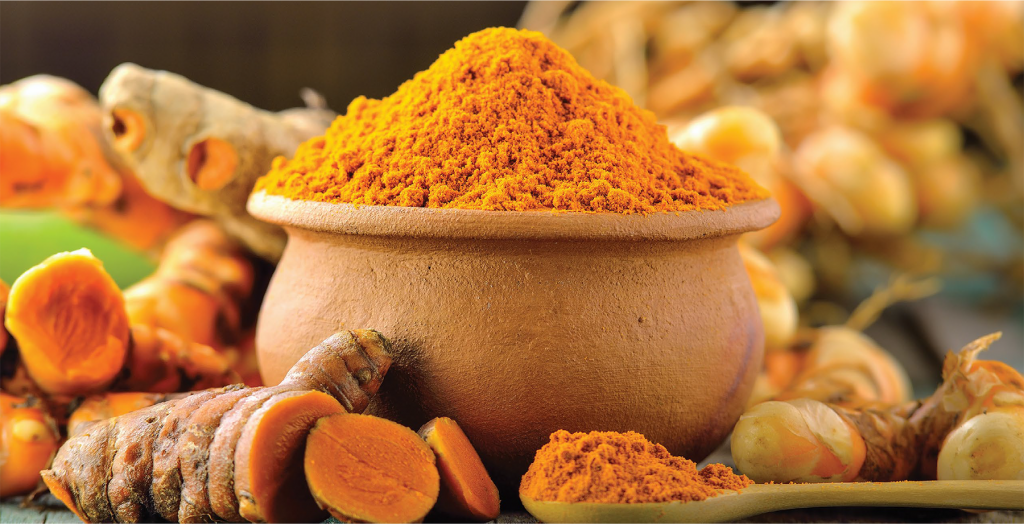Riddle me this, riddle me that. What spice looks like ginger and has a distinct golden yellow colour when in a powdered state? If you guessed ‘Tumeric’, then you are absolutely right. I’m sure it is no coincidence that this spice exists as ‘golden’. Turmeric has been a staple in Ayurvedic Medicine, used by Indians as early as 3000 B.C. It is traditionally used to treat skin conditions, digestive issues, as well as aches and pains. Today, turmeric has been mixed into creams for topical application, taken by mouth in capsule form and even the powder is mixed in with liquid and enjoyed as a drink. Historically though, Turmeric has been consumed as the ingredient in curry which gives it the tell-tale yellow colour. Our Caribbean palette has gathered recipes
from various parts of the world and due to our diverse culture, we enjoy curry in many forms including curried chicken, curried goat, curried chick peas and even curried mango (just to name a few). Recently, however; health and beauty ‘gurus’ have taken a liking to turmeric independent of the curry spice. Is it worth the hype?
Turmeric is made up of a number of components, curcumin being the main one which givesTurmeric the golden touch and magical powers. Because of all the attention this spice has gained, many scientists have conducted experiments, focusing on curcumin extract in concentrated forms.
Countless studies however have concluded that both curcumin and Turmeric have proven health benefits in the following conditions:
• Cancer
• Diabetes
• Liver Conditions
• Obesity
• Osteoarthritis
Additionally, the spice has been found to contain antifungal as well as antibacterial properties.
There have been many loop holes in concluding whether or not consuming turmeric in its commercial state actually provides medicinal benefits. This is due to the fact that in the state as we know it, when consumed, only 3% is actually available to our bodies and due to the instability of the spice, even less is absorbed in our systems. Most of it is passed out when we take trips to the bathroom.
However, one study done in 2006 showed that elderly Singaporeans who ate more curry had less decrease in brain function. This revealed the antioxidant and anti-inflammatory properties of turmeric, and because inflammation is a common factor amongst diseases such as Alzheimer’s, Arthritis and Heart Disease, supportive studies continue regarding the consumption of curcumin.
In order to gain maximum benefit for a few common conditions, the following dosages are recommended for consumptionn:
For arthritis in the joints; turmeric containing 1g curcumin per day can show maximum benefits in 8-12 weeks
Reduction in cholesterol levels, 700mg twice daily is beneficial
A reduction in inflammation, cholesterol and waist circumference was seen with a consumption of 2.4 g of turmeric daily for 8 weeks
Athletes who consumed 6g of curcumin 3 times daily helped to reduce muscle damage after exercise.
Studies have shown that combining turmeric with black pepper (which contains piperine), makes curcumin 2000 times more potent and available to the body. Curcumin is tolerated in doses as high as 12g per day, however; the side effects include nausea and stomach discomfort, which is a common effect in many persons who consume curried foods. Consuming turmeric in foods has been found to be the safest method to obtain the benefits from this golden spice. Experts have stated however, that while consuming turmeric on its own is mostly harmless, taking curcumin as a supplement in its concentrated form may be dangerous for individuals on blood thinning or anticoagulant medication such as aspirin, warfarin, ibuprofen and naproxen. Curcumin, if taken in conjunction with these medications, can reduce clotting time and increased bleeding especially in the case of surgery.
Turmeric has also been traditionally applied to the skin of brides before their wedding day to remove dead skin cells, revealing young rejuvenated skin, giving a natural and radiant glow. You can have glowing skin too. Adding a teaspoon of turmeric to your face masks will aid in the reduction of pimples and revitalised skin.
So enjoy your curried meals, twice daily, with a dash of black pepper to gain benefits from turmeric. The Indians certainly enjoyed every part of this magical spice, you should too.


